OVERVIEW
To dramatically boost your birding experience in Ecuador, welcome to the exploration of our privileged Amazon region. While the Amazon basin falls within several South American countries, a singularity occurs in Ecuador's Amazonia. The Equator line, the Andes mountain range, and, our Amazon territory blend together to give place to the most bio-diverse ecosystem in the world! Brace yourself for a birding trip jam-packed with unique bird species.
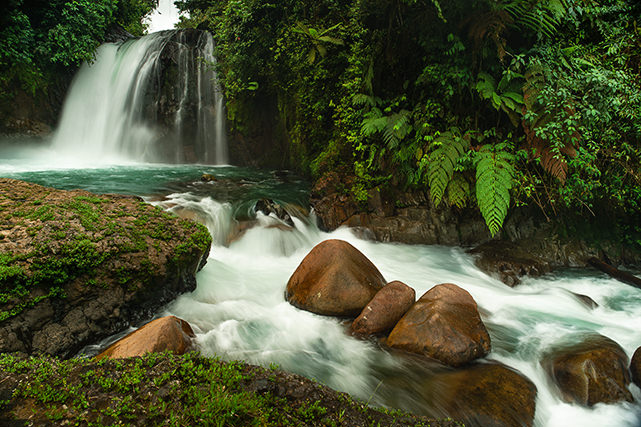 Be enchanted by the breathtaking scenery of the Upper Amazon region. © Jorge Luis Cruz Alcivar
Be enchanted by the breathtaking scenery of the Upper Amazon region. © Jorge Luis Cruz Alcivar
Our first chapter covers the Upper Amazon basin, stretching from 3000 m (9800 feet) all the way down to 1200 m (4000 feet). We will explore the Amazon's mountainous region made up of lush montane forest,  deep-green foothill forests, and, crystal clear rivers that feed into the largest tributary of the Amazon river. This region is exceptionally good for birding for its highly sought-after mountain-toucans, mountain-tanagers, fruiteaters, tanagers, jays, caciques, antbirds, and, notably, for its abounding hummingbird species, most of which don't occur in the Choco slope (5 & 8 day trips). This region is unfortunately missed by most birders, who, unknowingly skip this must-see! birding area by flying directly from Quito to Coca city into the Amazon lowlands which we offer as a separate trip.
deep-green foothill forests, and, crystal clear rivers that feed into the largest tributary of the Amazon river. This region is exceptionally good for birding for its highly sought-after mountain-toucans, mountain-tanagers, fruiteaters, tanagers, jays, caciques, antbirds, and, notably, for its abounding hummingbird species, most of which don't occur in the Choco slope (5 & 8 day trips). This region is unfortunately missed by most birders, who, unknowingly skip this must-see! birding area by flying directly from Quito to Coca city into the Amazon lowlands which we offer as a separate trip.
FOR OUR 5 DAY AMAZON LOWLANDS TOUR CLICK HERE
DETAILED ITINERARY
DAY 1
Pick-up from Quito airport and transfer to San Jorge Eco-lodge Quito.
Overnight: San Jorge Eco-lodge Quito.
DAY 2
Birding Papallacta Pass, Cayambe-Coca National Park & Cuyuja River:
Now that we've covered the most birdy areas of the Choco slope, we embark into an essentially new world, the enchanted forests of the Upper Amazon Basin. After breakfast we start driving towards the Amazonia slope gateway, the famous Papallacta Pass. 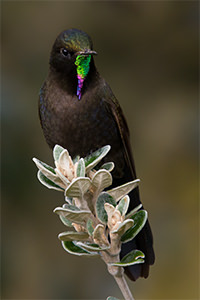 This stunning treeline forest is home to several jewels including the
This stunning treeline forest is home to several jewels including the  Rufous-bellied Seedsnipe, Black-chested Buzzard-Eagle, Red-rumped Bush-Tyrant, Bar-bellied Woodpecker, White-chinned Thistletail, Many-stripped Canastero, Rainbow-bearded Thornbill, Blue-mantled Thornbill, Viridian Metaltail, Giant Conebill, Paramo Seedeater, Paramo Tapaculo, and, many more. Papallacta Pass it's also one of the best places to see the Andean Bear. We continue birding along the Papallacta Lagoon to record several aquatic bird species that will not occur elsewhere including the Yellow-billed Pintail, Andean Teal, Neotropic Cormorant, and with some luck, the elusive Noble Snipe. At around noon, we will be rewarded with a delicious boxed lunch surrounded by another sublime Andean landscape.
Rufous-bellied Seedsnipe, Black-chested Buzzard-Eagle, Red-rumped Bush-Tyrant, Bar-bellied Woodpecker, White-chinned Thistletail, Many-stripped Canastero, Rainbow-bearded Thornbill, Blue-mantled Thornbill, Viridian Metaltail, Giant Conebill, Paramo Seedeater, Paramo Tapaculo, and, many more. Papallacta Pass it's also one of the best places to see the Andean Bear. We continue birding along the Papallacta Lagoon to record several aquatic bird species that will not occur elsewhere including the Yellow-billed Pintail, Andean Teal, Neotropic Cormorant, and with some luck, the elusive Noble Snipe. At around noon, we will be rewarded with a delicious boxed lunch surrounded by another sublime Andean landscape.
 Our upper Amazonia trip visits the best location to see the fabulous Rainbow-bearded Thornbill © Jorge Luis Cruz Alcivar
Our upper Amazonia trip visits the best location to see the fabulous Rainbow-bearded Thornbill © Jorge Luis Cruz Alcivar
After lunch we drive for 40 minutes to Cayambe-Coca National Park. This dwarf Andean forest is home to very localized bird species such as the Masked Mountain-Tanager, that can be seasonally fairly common to see. We will focus on getting the Mountain Avocetbill,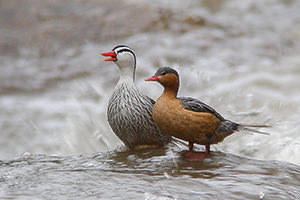 Black-backed Bush-Tanager, Pale-naped Brush-Finch, Black-headed Hemispingus, Black-capped Hemispingus, Powerful Woodpecker,Agile Tit-Tyrant, Crowned Chat-Tyrant, Ash-colored Tapaculo, Golden-crowned Tanager, and, a second chance at the elegant Plushcap. After Cayambe Coca, we descend to Cuyuja river and we spend the rest of the afternoon looking for the Torrent Duck, Red-hooded Tanager, Grey-breasted Mountain-Toucan, Black-eared Hemispingus, Slaty Brush-Finch, Citrine Warbler, and with a bit of luck, the Andean Potoo. We will also make a stop by a hummingbird feeding station to look out for the Chesnut-breasted Coronet, Collared Inca, Long-tailed Sylph, Tourmaline Sunangel, and, casually, a Glowing Puffleg. Overnight: Baeza Valley Eco-lodge.
Black-backed Bush-Tanager, Pale-naped Brush-Finch, Black-headed Hemispingus, Black-capped Hemispingus, Powerful Woodpecker,Agile Tit-Tyrant, Crowned Chat-Tyrant, Ash-colored Tapaculo, Golden-crowned Tanager, and, a second chance at the elegant Plushcap. After Cayambe Coca, we descend to Cuyuja river and we spend the rest of the afternoon looking for the Torrent Duck, Red-hooded Tanager, Grey-breasted Mountain-Toucan, Black-eared Hemispingus, Slaty Brush-Finch, Citrine Warbler, and with a bit of luck, the Andean Potoo. We will also make a stop by a hummingbird feeding station to look out for the Chesnut-breasted Coronet, Collared Inca, Long-tailed Sylph, Tourmaline Sunangel, and, casually, a Glowing Puffleg. Overnight: Baeza Valley Eco-lodge.
DAY 3
Birding San Jorge Cosanga-Yanayacu Bird Reserve & Upper Sumaco
After breakfast we drive for 40 minutes to our San Jorge Cosanga-Yanayacu Bird Reserve. Our exuberant protected reserve is located in the heart of the Cosanga-Yanayacu Christmas Bird Count Area with a world record of 600 bird species recorded in one day.  Here, we will bird along "Las Caucheras Road" and some of our target species will include: Chestnut-breasted Chlorophonia, Grass-green Tanager, Andean Motmot, Saffron-crowned Tanager, Yellow-billed Cacique, Mountain Cacique, Streak-headed Antbird, Emerald Toucanet,
Here, we will bird along "Las Caucheras Road" and some of our target species will include: Chestnut-breasted Chlorophonia, Grass-green Tanager, Andean Motmot, Saffron-crowned Tanager, Yellow-billed Cacique, Mountain Cacique, Streak-headed Antbird, Emerald Toucanet, 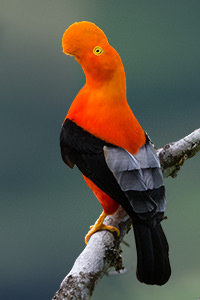 Rufous-headed Pygmy-Tyrant, Green-and-black Fruiteater, Dusky Piha, Capped Conebill, Fawn-breasted Tanager, White-capped Parrot, White-capped Tanager, Lemon-browed Flycatcher, White-bellied Antpitta, Black-billed Mountain-Toucan, and, with a bit of luck, the elusive Wattled Guan. After lunch we explore the Upper Sumaco road to look out for beautiful species such as the Sunbittern, Grey-mantled Wren, Golden-eared Tanager, Short-tailed Antthrush, Long-tailed Tapaculo, Spot-winged Antbird, Spot-breasted Woodpecker, Red-breasted Meadowlark, Southern Lapwing, Chestnut-bellied Seedeater, White-tipped Sicklebill, Violet-fronted Brilliant, Green-backed Hillstar, and, the tiny Gorgeted Woodstar. In the late afternoon we'll visit one of the best Andean Cock-of-the-rock LEK in Ecuador to appreciate the amazing color of the eastern subspecies. Overnight: Baeza Valley Eco-lodge
Rufous-headed Pygmy-Tyrant, Green-and-black Fruiteater, Dusky Piha, Capped Conebill, Fawn-breasted Tanager, White-capped Parrot, White-capped Tanager, Lemon-browed Flycatcher, White-bellied Antpitta, Black-billed Mountain-Toucan, and, with a bit of luck, the elusive Wattled Guan. After lunch we explore the Upper Sumaco road to look out for beautiful species such as the Sunbittern, Grey-mantled Wren, Golden-eared Tanager, Short-tailed Antthrush, Long-tailed Tapaculo, Spot-winged Antbird, Spot-breasted Woodpecker, Red-breasted Meadowlark, Southern Lapwing, Chestnut-bellied Seedeater, White-tipped Sicklebill, Violet-fronted Brilliant, Green-backed Hillstar, and, the tiny Gorgeted Woodstar. In the late afternoon we'll visit one of the best Andean Cock-of-the-rock LEK in Ecuador to appreciate the amazing color of the eastern subspecies. Overnight: Baeza Valley Eco-lodge
DAY 4
Birding BRAND NEW! San Jorge Guacamayos Bird Reserve & San Jorge Sumaco Bajo
After breakfast we drive for 45 minutes to explore San Jorge Guacamayos, one of Ecuador's most biodiverse and pristine natural reserves. Our blessed location between Antisana National Park and Napo-Galeras National Park will allow us to see flocks of birds from both the montane and the foothill forests.  We will look out for the Paradise Tanager, Greenish Puffleg, Booted Racket-tail, Collared Inca, Bronzy Inca,
We will look out for the Paradise Tanager, Greenish Puffleg, Booted Racket-tail, Collared Inca, Bronzy Inca, 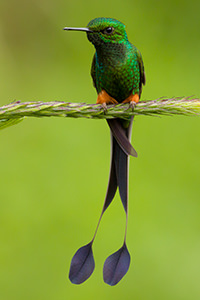 Napo Sabrewing, Grey-chinned Hermit, Oleaginous Hemispingus, Deep-blue Flowerpiercer, White-rimmed Brush-Finch, Grass-green Tanager, Blue-browed Tanager, and, with some luck the magnificient Greater Scythebill, and the Scarlet-breasted Fruiteater. We'll have a delicious lunch at our open-air restaurant and we'll continue exploring different trails to look out for the Black-billed Mountain-Toucan, Slate-crowned Antpitta, Blue-naped Chlorophonia, Olivaceous Piha, Golden-collared Honeycreeper, Brown-billed Scythebill, Barred Antthrush, Rufous-crested Tanager, Vermilion Tanager, Black-chested Fruiteater, Black-streaked Puffbird, Yellow-vented Woodpecker, and with a bit of luck the Solitary Eagle, and, the Peruvian Antpitta. Overnight: Baeza Valley Eco-lodge.
Napo Sabrewing, Grey-chinned Hermit, Oleaginous Hemispingus, Deep-blue Flowerpiercer, White-rimmed Brush-Finch, Grass-green Tanager, Blue-browed Tanager, and, with some luck the magnificient Greater Scythebill, and the Scarlet-breasted Fruiteater. We'll have a delicious lunch at our open-air restaurant and we'll continue exploring different trails to look out for the Black-billed Mountain-Toucan, Slate-crowned Antpitta, Blue-naped Chlorophonia, Olivaceous Piha, Golden-collared Honeycreeper, Brown-billed Scythebill, Barred Antthrush, Rufous-crested Tanager, Vermilion Tanager, Black-chested Fruiteater, Black-streaked Puffbird, Yellow-vented Woodpecker, and with a bit of luck the Solitary Eagle, and, the Peruvian Antpitta. Overnight: Baeza Valley Eco-lodge.
 Brand New! San Jorge Sumaco Bird Reserve's stunning forest densely draped with mosses, ferns, orchids, and bromeliads. © Jorge Luis Cruz Alcivar
Brand New! San Jorge Sumaco Bird Reserve's stunning forest densely draped with mosses, ferns, orchids, and bromeliads. © Jorge Luis Cruz Alcivar
DAY 5
Birding Archidona Hummingbird Reserve
After breakfast we drive for 30 minutes to Archidona Hummingbird Reserve. Extensive gardens covered with flowering vervenas are home to numerous hummingbird species that occur at this elevation only.  We will look out for the iconic Wire-crested Throntail, Violet-headed Hummingbird, Rufous-throated Sapphire, Napo Sabrewing, Rufous-vented Whitetip, Black-throated Brilliant, Fork-tailed Woodnymph,
We will look out for the iconic Wire-crested Throntail, Violet-headed Hummingbird, Rufous-throated Sapphire, Napo Sabrewing, Rufous-vented Whitetip, Black-throated Brilliant, Fork-tailed Woodnymph, 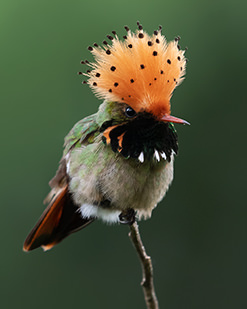 Black-throated Brilliant, Blue-fronted Lancebill, Green Hermit, Ecuadorian Piedtail, Pink-throated Brilliant, and, the amazing Spangled Coquette. We'll have a delicious boxed lunch and we'll continue exploring the reserve for other birds including the Fiery-throated Fruiteater, Lafresnaye's Piculet, Plain-backed Antpitta, Wing-banded Wren, White-crowned Manakin, Coppery-chested Jacamar, Ecuadorian Tyrannulet, Spotted Tanager, Orange-breasted Falcon, Chestnut-crowned Gnateater, and the endangered Military Macaw. Overnight: N/A - 3:00PM transfer to any hotel in Quito area or to Quito airport.
Black-throated Brilliant, Blue-fronted Lancebill, Green Hermit, Ecuadorian Piedtail, Pink-throated Brilliant, and, the amazing Spangled Coquette. We'll have a delicious boxed lunch and we'll continue exploring the reserve for other birds including the Fiery-throated Fruiteater, Lafresnaye's Piculet, Plain-backed Antpitta, Wing-banded Wren, White-crowned Manakin, Coppery-chested Jacamar, Ecuadorian Tyrannulet, Spotted Tanager, Orange-breasted Falcon, Chestnut-crowned Gnateater, and the endangered Military Macaw. Overnight: N/A - 3:00PM transfer to any hotel in Quito area or to Quito airport.
OR - TO CONTINUE WITH OUR 5 DAY AMAZON LOWLANDS TOUR CLICK HERE
END OF ITINERARY
